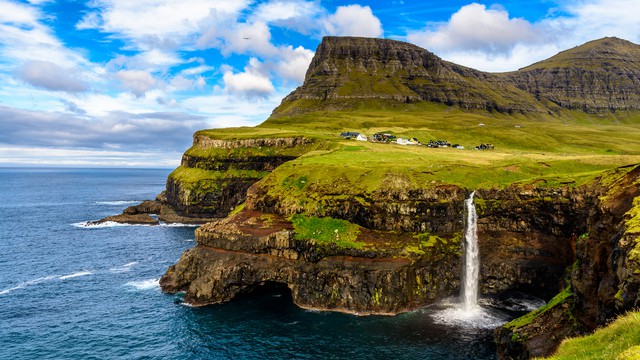Average weather for Faroe Islands in July
It's cool in July in Faroe Islands with an average temperature of 13°C. Temperatures this month range from a low of 12°C to a high of 14°C. At night, you can expect temperatures between 9°C and 11°C.
Start of July
The month of July starts in Faroe Islands with cool temps, averaging around 13°C during the day and nights around 10°C. A few showers might pop up early in the month, but overall, it’ll stay mostly sunny and dry. Go for a warm jacket, sweater or hoodie, and long pants.
Mid July
By mid-July, daytime temps rise to around 14°C, with nights around 10°C. There’s a chance of some showers during this time, but plenty of dry and sunny days too.
End of July
By the end of July, the average daytime temperature in Faroe Islands is around 14°C, while nighttime temps are about 11°C. A shower might pop up, but overall, the weather will be dry and sunny.
Water temperature
The water temperature at Faroe Islands is 8°C this month. This is too cold to swim without protective gear.
In July, there is an average of 52 mm of precipitation, spread over 11 days. The wind speed is around 4 Bft, mostly coming from the Southwest.
Faroe Islands in July |
New York | ||
|---|---|---|---|
| 13°C | 31°C | ||
| 14°C | 33°C | ||
| 12°C | -5°C | ||
| 52 mm | 160 mm | ||
| 11 days | 18 days | ||
UV index
The UV index is a maximum of 7 this month. That's a moderate to high value on the intensity scale of 1 to 11. Unprotected skin can burn within 15-25 minutes.
Temperature records
With 19°C in 2023, Faroe Islands reached the highest temperature in July over the past 10 years. The lowest daytime temperature in this month was 8°C in 2023. The extreme nighttime temperatures ranged from a lowest recorded value of 4°C to a highest value of 13°C.
Check out the climate of Faroe Islands for all months and discover the best travel time
Daily Temperature in July in Faroe Islands
This chart shows the average daily high and low temperatures in July for Faroe Islands, in degrees Celsius. The red line represents the highs, and the blue line shows the lows. The days of the month are displayed at the bottom of the chart. The data, based on historical observations, provide the average temperatures for this month.
Weather experiences in July in Faroe Islands
The Faroe Islands experienced their peak in July. Sometimes ... more
Daily Precipitation in July in Faroe Islands
The chart below shows the average daily precipitation in July for Faroe Islands, measured in millimeters over the past few years. Precipitation is always measured as water, even if it’s snow or hail. The days of the month are listed at the bottom of the chart.
A low average precipitation means that the chance of rain on that day is usually small, while a higher average suggests that it rained more often. But remember, it’s just an average, and every day can be different. Based on historical weather data for July, you can expect about 11 days of precipitation in Faroe Islands.
Daily UV index in July in Faroe Islands
This chart shows the average daily UV index in July in Faroe Islands, with the UV index ranging from 0 to a maximum of 11. The bottom of the chart shows the days of the month. Based on historical data, this chart provides an idea of the daily UV radiation levels you can expect.
Temperature in July in Faroe Islands over the years
This chart shows the average temperature in July in Faroe Islands, measured in degrees Celsius, over the past few years.
Total precipitation in July in Faroe Islands over the years
This chart shows the average precipitation in July in Faroe Islands, measured in millimeters over the past years. Precipitation is always measured as water, whether it’s snow or hail.
Daily weather in July for Faroe Islands
Click on any day in July to get detailed info about the usual weather on that day in Faroe Islands. Check out the historical temperatures and precipitation over the past 10 years on this day.































Weather experiences in July in Faroe Islands
The weather in July in Faroe Islands is rated an average of 1,5 out of 5 stars by 2 visitors. Have you been to Faroe Islands? Share your weather experience to help other visitors.
Write your own reviewThe Faroe Islands experienced their peak in July. Sometimes it is magically beautiful with light fog and warm days. Often it is gray, rainy and cool. For lovers of unpredictable weather.— This text is automatically translated to English
Have you been to Faroe Islands in July?
Share your weather experience in July in Faroe Islands.
Average weather in Faroe Islands by month
Click on a month below to see detailed weather info for Faroe Islands. Based on historical weather data, you can see the average temperature, precipitation, wind, and UV index for each day of the month.
Or check out the climate of Faroe Islands for all months at once
